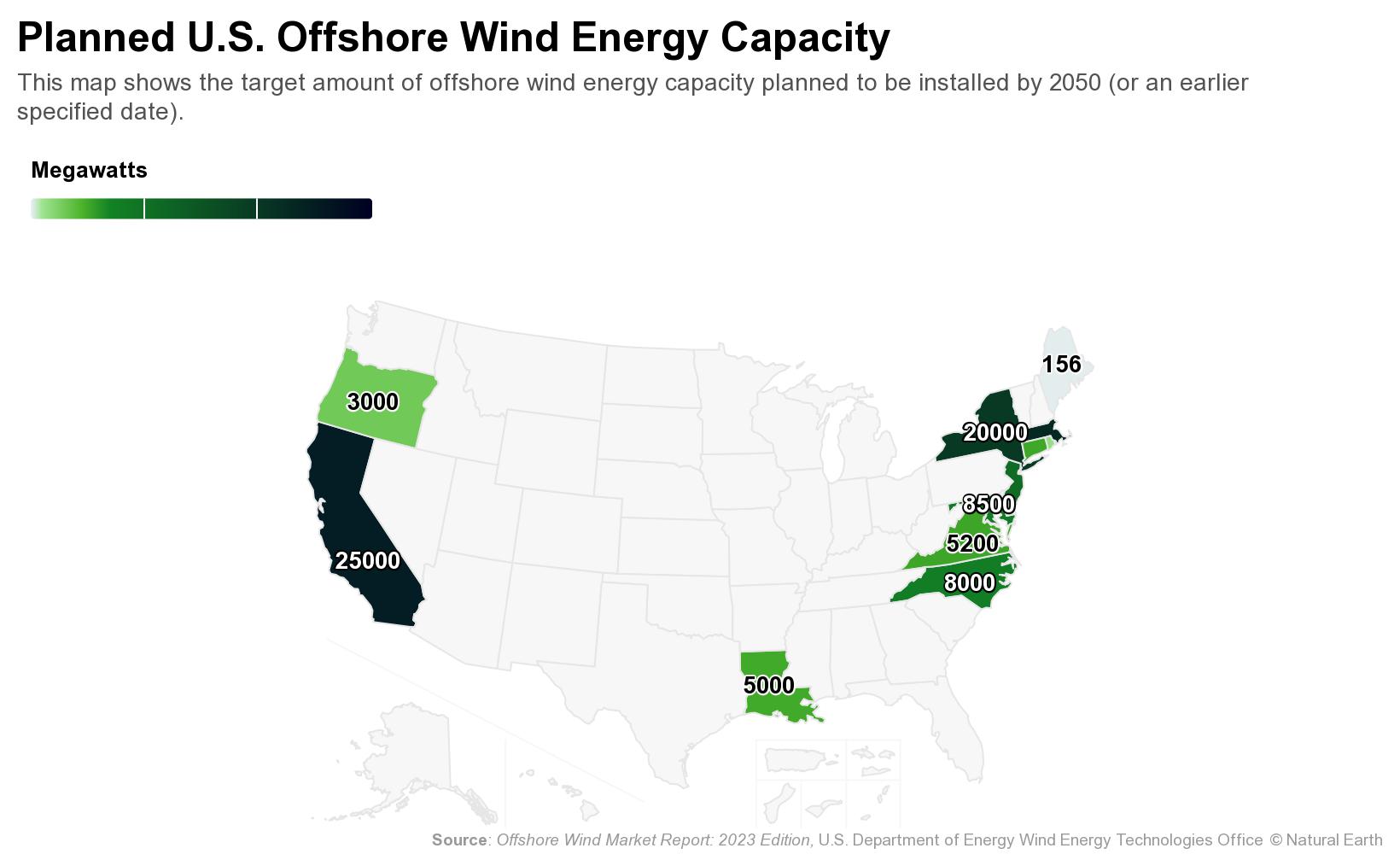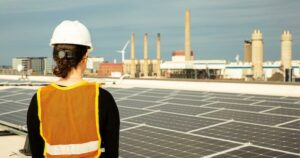At the end of October, Danish wind giant Ørsted announced that it is canceling its pair of big offshore projects in New Jersey — marking the latest in a series of setbacks for the U.S. industry. That same day, Virginia utility Dominion Energy gained final approval for its $9.8 billion Coastal Virginia project, the largest wind farm planned for U.S. waters.
Those developments highlight the contradictory position for offshore wind in the U.S. Supported by generous taxpayer dollars at both the state and federal levels, the industry has been forced to sharply scale back in the last six months as supply chain snarls, rising costs, regulatory hold-ups and shifting prices for renewable energy have caused the delay or cancellation of several major projects.
Dominion Energy, however, is undaunted.
The 2.6-GW Coastal Virginia project "continues to move forward on time and on budget," said Dominion president, chair and CEO Robert Blue at an October event marking the arrival of the first monopiles (the enormous steel towers that hold up the turbine blades) at the Port of Virginia.
Dominion’s success is due to regulatory good fortune, local support, bipartisan legislation in Richmond that calls for 5.2 GW of offshore wind in state waters, and abundant federal tax credits that have helped mitigate the company’s risk.
None of that guarantees that the project will actually get built and go into service, as planned, in 2026, nor that the company and the Commonwealth of Virginia will achieve their clean energy goals. At a time when the future of offshore wind in the United States is in serious doubt, though, the success of Coastal Virginia Offshore Wind (CVOW) would provide the beleaguered industry with a road map.
The year of falling apart
Rising inflation and supply chain delays have stalled or directly ended development of a number of planned offshore wind farms in the U.S.
- Ørsted is pulling out of the Ocean Wind I and II projects off the New Jersey shore, and will take a $4 billion loss related to the projects.
- Three projects slated to provide 3.2 GW to Massachusetts and Connecticut have also been shut down.
- Siemens Gamesa announced on Nov. 15 that it is suspending construction on the Portsmouth Marine Terminal, slated to supply turbines for Dominion’s Coastal Virginia project.
- The industry is almost certainly not going to meet the Biden administration’s goal of having 30 GW of offshore wind in operation by 2030.
In total, close to $22 billion in planned offshore wind development investment in the U.S. has been canceled or indefinitely delayed in recent months.
S&P Global Commodities Insights said it would downgrade its outlook for 2030 offshore wind capacity from its current 22 gigawatts expectation, a number already well below the Biden administration’s 30 GW target.
The U.S. industry is in its infancy compared to offshore wind development in Europe. Current operating offshore wind power capacity in U.S. waters totals only 42 MW, a fraction of the 32 GW already producing electricity in Europe, where developers had at least a decade’s head start.
"Macroeconomic headwinds are creating challenges for some projects," said John Podesta, senior advisor to the president for clean energy innovation and implementation, on a Nov. 16 call with reporters, "but momentum remains on the side of expanding the U.S. offshore wind industry."

Dominion’s perfect storm: legislative, regulatory, and community support
Dominion enjoys four main advantages over its counterparts in other states: legislative support; a favorable regulatory environment; little of the NIMBYism plaguing other developers; and an extensive community outreach arm toned by years of seeking, and often winning, community support for big construction projects.
In 2020, Virginia passed the Virginia Clean Economy Act (VCA), which declared 5.2 GW of offshore wind energy to be in the public’s best interest (and which mandates Dominion, already serving two-thirds of the state’s population, to deliver electricity from 100 percent renewable sources by 2045). "The VCA was really instrumental" in giving Dominion’s offshore wind program momentum, said Julia Pendleton, program director at Southeastern Wind Coalition. Virginia’s State Corporation Commission (SCC), the body with the power to approve or reject Dominion’s application, "was really inclined to approve the CVOW proposal," Pendleton added.
That leads to another key factor: Dominion’s status as a regulated utility. Private developers such as Ørsted must finance multi-billion-dollar projects themselves, or find investors, and must seek customers via power-purchase agreements. Dominion, by contrast, will fold the cost of the Coastal Virginia project into its state-approved electricity rates. And Dominion is a vertically integrated power company, meaning that it owns the generation, the transmission, and the distribution of electricity, enabling it to firmly forecast and manage costs.
"As a regulated project, we secured agreements early with offshore wind suppliers for material and services, while giving them confidence in our project’s completion," said Jeremy Slayton, a Dominion spokesperson. "We mitigated risk to the greatest extent possible by using fixed price contracts as well as hedging currency and commodity costs."
Regulatory certainty also gave Dominion a long runway, said Pendleton: "Dominion was so ahead of the game here … so many of their contracts proceeded prior to the industry facing supply chain issues and inflationary pressure."
It should also be noted that Dominion has a long history of wielding outsized — and in critics’ views unseemly — political clout in Richmond. Dominion has used its quasi-monopoly in Virginia to support, and in some cases write, legislation that "gradually neutered the SCC, freed the utility’s rates from regulation, and allowed Dominion to overcharge Virginians … by about $2 billion … on their electric bills," wrote George Packer in an investigation in the Atlantic. (Dominion Energy did not respond to questions about its political activity.)
In 2021 Dominion agreed to a settlement with the SCC that included $330 million in refunds to customers along with more than $300 million in funding for various projects — including Coastal Virginia Offshore Wind.
Yes, in my backyard
Residents of Virginia’s 10,000 miles of shoreline, meanwhile, have been comparatively muted in their objections to a project that will eventually comprise 176 giant turbines.
"From the outset, this project has been very popular in the Hampton Roads region and across Virginia,” said Slayton, citing “broad-based support from bipartisan political leaders, environmental groups, labor unions, economic developers, local businesses and residents from across the region.”
It helps that the project zone is 27 miles off Virginia’s southern coast, making it virtually invisible from the hotel balconies of Virginia Beach. And Dominion, well-versed in the art of public relations and community outreach, mounted an exhaustive campaign to win the hearts and minds of local communities — including an agreement to cap customer costs in the case of budget overruns.
The IRA and offshore incentives
Dominion has also benefited from an array of tax rebates and other government support. The Inflation Reduction Act features the section 48 investment tax credit (ITC), which provides a 30 percent credit for the cost of offshore wind components for projects that begin construction before 2026. A recent update from the Treasury Department allows tax credits for additional components for offshore wind farms, including standalone battery storage and undersea cables.
The federal support "will provide critical certainty for offshore wind projects as they finalize investment decisions," said Podesta.
Projects can also receive stackable 10 percent bonus credits — in addition to the 30 percent available from the ITC — for using domestic steel and manufactured products, locating the facilities in fossil-fuel powered communities and establishing small power stations in low-income communities or on tribal lands. And the renewable electricity production tax credit gives owners and developers annual federal income tax credits for every kilowatt-hour of carbon-free electricity supplied to the power grid for up to 10 years.
All of which means that Coastal Virginia will cost far less over time than the sticker price indicates. And Blue, the Dominion CEO, said on the company’s third-quarter earnings call that it is working "to identify a noncontrolling equity partner" — an outside investor — in the project.
Unless the tax credits are repealed, other offshore facilities will receive similarly ample government support. Which means that offshore wind is far from dead in the U.S.
"As we move into 2024, the industry is entering a new phase and learning from our mistakes," said Sam Salustro, vice president of strategic communication at Oceantic Network, an industry group that supports offshore wind. "The total pipeline of projects approved to begin construction will soon exceed 7 GW, a substantial increase in just the last year, and another 10 GW is in a near-term pipeline for approval."
In late November, installers placed the first turbine for the 136-MW South Fork Wind project, the first facility off the coast of New York state. The developers? New England power provider Eversource Energy and Ørsted.
- SEO Powered Content & PR Distribution. Get Amplified Today.
- PlatoData.Network Vertical Generative Ai. Empower Yourself. Access Here.
- PlatoAiStream. Web3 Intelligence. Knowledge Amplified. Access Here.
- PlatoESG. Carbon, CleanTech, Energy, Environment, Solar, Waste Management. Access Here.
- PlatoHealth. Biotech and Clinical Trials Intelligence. Access Here.
- Source: https://www.greenbiz.com/article/how-dominion-energy-creating-98-billion-road-map-offshore-wind
- :has
- :is
- :not
- :where
- ][p
- $UP
- 000
- 10
- 100
- 15%
- 16
- 2020
- 2021
- 2024
- 2026
- 2030
- 22
- 27
- 30
- 7
- 8
- a
- About
- abundant
- Achieve
- across
- Act
- activity
- actually
- added
- addition
- Additional
- advantages
- advisor
- Agreement
- agreements
- ahead
- allowed
- allows
- almost
- along
- already
- also
- an
- and
- announced
- annual
- Another
- Application
- approval
- approve
- approved
- ARE
- ARM
- Array
- arrival
- Art
- AS
- At
- available
- back
- battery
- battery storage
- BE
- Beach
- been
- before
- begin
- below
- BEST
- biden
- Big
- Billion
- Bills
- bipartisan
- Blue
- body
- Bonus
- both
- budget
- built
- businesses
- but
- by
- cables
- call
- Calls
- Campaign
- CAN
- canceled
- Capacity
- case
- cases
- caused
- ceo
- certainly
- certainty
- chain
- Chair
- challenges
- citing
- clean
- clean energy
- Close
- CNBC
- coalition
- Coast
- coastal
- commission
- Commodities
- commodity
- commonwealth
- Communication
- Communities
- community
- Community Outreach
- company
- Company’s
- comparatively
- compared
- completion
- components
- confidence
- construction
- continues
- contracts
- contrast
- CORPORATION
- Cost
- Costs
- counterparts
- Creating
- credit
- Credits
- critical
- Currency
- Current
- customer
- Customers
- danish
- day
- dead
- decisions
- delay
- Delayed
- delays
- deliver
- Department
- developers
- Development
- developments
- DID
- directly
- Director
- distribution
- dollars
- Domestic
- dominion energy
- doubt
- down
- Downgrade
- due
- Early
- Earnings
- earnings call
- Economic
- economy
- Electric
- electricity
- enabling
- end
- energy
- energy innovation
- England
- enormous
- entering
- Environment
- environmental
- equity
- establishing
- Ether (ETH)
- Europe
- Event
- eventually
- Every
- exceed
- expanding
- expectation
- extensive
- extent
- facilities
- Facility
- facing
- factor
- Falling
- far
- farm
- Farms
- favorable
- Features
- Federal
- final
- finalize
- finance
- Find
- firmly
- First
- fixed
- For
- Forecast
- fork
- Fortune
- Forward
- four
- fraction
- from
- funding
- future
- gained
- game
- gave
- generation
- generous
- George
- get
- giant
- gives
- Giving
- Global
- Go
- goal
- Goals
- going
- good
- Government
- government support
- gradually
- greatest
- Grid
- Group
- Group’s
- guarantees
- had
- Hampton
- Have
- having
- head
- headwinds
- hearts
- hedging
- helped
- helps
- here
- Highlight
- history
- hold
- hotel
- How
- However
- HTML
- HTTPS
- i
- identify
- ii
- implementation
- in
- In other
- Inclined
- included
- Including
- Income
- income tax
- Increase
- indicates
- industry
- inflation
- Inflationary
- Innovation
- insights
- instrumental
- integrated
- interest
- into
- investigation
- investment
- investor
- Investors
- invisible
- IRA
- issues
- IT
- ITS
- Jersey
- John
- julia
- just
- Key
- key factor
- labor
- lands
- largest
- Last
- Last Year
- Late
- latest
- leaders
- Leads
- learning
- least
- Legislation
- Legislative
- less
- levels
- little
- local
- local businesses
- locating
- Long
- Macroeconomic
- Main
- major
- Making
- manage
- mandates
- manufactured
- many
- map
- Marine
- marking
- massachusetts
- material
- meaning
- means
- Meanwhile
- Meet
- million
- minds
- mistakes
- Mitigate
- Momentum
- months
- more
- move
- move forward
- must
- my
- network
- New
- New Jersey
- New York
- New York state
- nor
- noted
- nov
- November
- number
- ocean
- october
- of
- off
- often
- on
- only
- operating
- operation
- or
- Other
- our
- out
- Outlook
- outreach
- outside
- over
- owners
- owns
- pair
- partner
- passed
- percent
- perfect
- phase
- pipeline
- placed
- planned
- plato
- Plato Data Intelligence
- PlatoData
- political
- Popular
- population
- position
- possible
- power
- power company
- Power grid
- powered
- president
- pressure
- price
- Prices
- Prior
- private
- producing
- Production
- Products
- Program
- project
- projects
- proposal
- provide
- provider
- provides
- public
- Public Relations
- pulling
- Questions
- Rates
- really
- rebates
- receive
- recent
- reduction
- refunds
- region
- regulated
- Regulation
- regulatory
- related
- relations
- remains
- Renewable
- renewable energy
- residents
- Respond
- rising
- Risk
- road
- roads
- ROBERT
- runway
- s
- Said
- Sam
- same
- Scale
- Section
- Secured
- Seek
- seeking
- senior
- Senior Advisor
- Series
- serious
- service
- Services
- serving
- Setbacks
- settlement
- several
- SHIFTING
- should
- shut
- Shut down
- side
- Similarly
- SIX
- Six months
- small
- So
- some
- Soon
- Sources
- South
- Southern
- spokesperson
- standalone
- start
- State
- States
- Stations
- Status
- steel
- storage
- Storm
- Strategic
- substantial
- success
- such
- supplied
- suppliers
- supply
- supply chain
- support
- Supported
- Supports
- Take
- Target
- tax
- tax credit
- Taxpayer
- Terminal
- than
- that
- The
- The Future
- The Projects
- The State
- their
- Them
- themselves
- they
- this
- though?
- time
- to
- Total
- treasury
- Treasury Department
- Tribal
- turbine
- two-thirds
- u.s.
- Unions
- United
- United States
- Update
- us
- used
- using
- utility
- various
- vertically
- very
- via
- vice
- Vice President
- views
- virginia
- virtually
- was
- Waters
- we
- WELL
- when
- which
- while
- will
- win
- wind
- wind energy
- wind farms
- wind power
- winning
- with
- working
- would
- write
- wrote
- year
- years
- york
- zephyrnet











